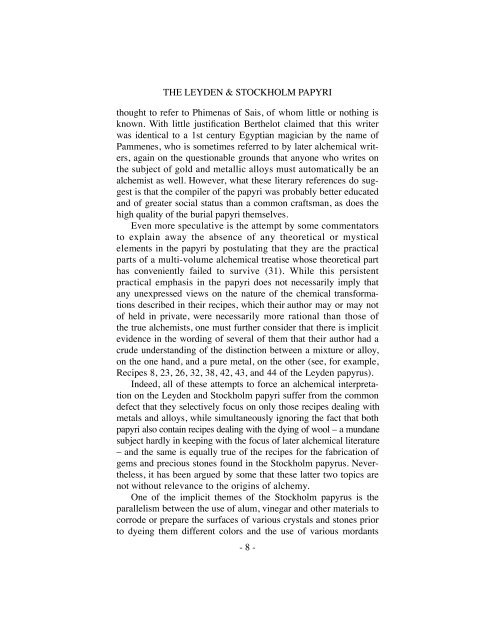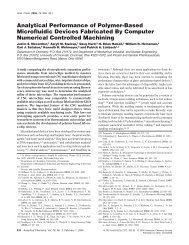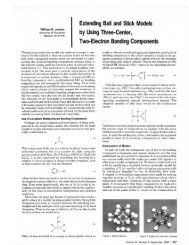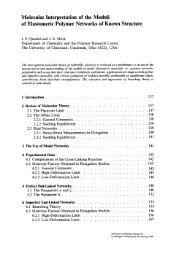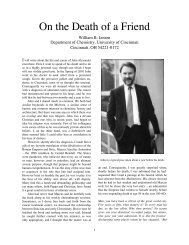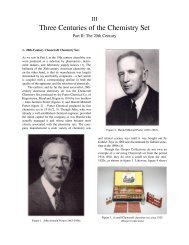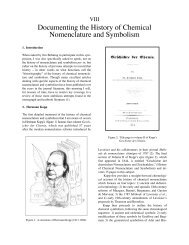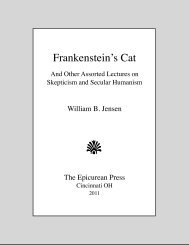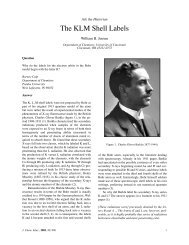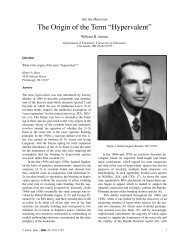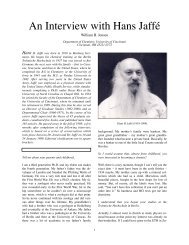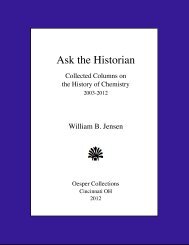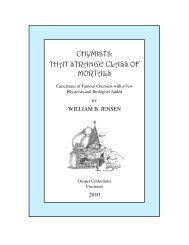The Leyden and Stockholm Papyri - University of Cincinnati
The Leyden and Stockholm Papyri - University of Cincinnati
The Leyden and Stockholm Papyri - University of Cincinnati
Create successful ePaper yourself
Turn your PDF publications into a flip-book with our unique Google optimized e-Paper software.
THE LEYDEN & STOCKHOLM PAPYRI<br />
thought to refer to Phimenas <strong>of</strong> Sais, <strong>of</strong> whom little or nothing is<br />
known. With little justification Berthelot claimed that this writer<br />
was identical to a 1st century Egyptian magician by the name <strong>of</strong><br />
Pammenes, who is sometimes referred to by later alchemical writers,<br />
again on the questionable grounds that anyone who writes on<br />
the subject <strong>of</strong> gold <strong>and</strong> metallic alloys must automatically be an<br />
alchemist as well. However, what these literary references do suggest<br />
is that the compiler <strong>of</strong> the papyri was probably better educated<br />
<strong>and</strong> <strong>of</strong> greater social status than a common craftsman, as does the<br />
high quality <strong>of</strong> the burial papyri themselves.!<br />
! Even more speculative is the attempt by some commentators<br />
to explain away the absence <strong>of</strong> any theoretical or mystical<br />
elements in the papyri by postulating that they are the practical<br />
parts <strong>of</strong> a multi-volume alchemical treatise whose theoretical part<br />
has conveniently failed to survive (31). While this persistent<br />
practical emphasis in the papyri does not necessarily imply that<br />
any unexpressed views on the nature <strong>of</strong> the chemical transformations<br />
described in their recipes, which their author may or may not<br />
<strong>of</strong> held in private, were necessarily more rational than those <strong>of</strong><br />
the true alchemists, one must further consider that there is implicit<br />
evidence in the wording <strong>of</strong> several <strong>of</strong> them that their author had a<br />
crude underst<strong>and</strong>ing <strong>of</strong> the distinction between a mixture or alloy,<br />
on the one h<strong>and</strong>, <strong>and</strong> a pure metal, on the other (see, for example,<br />
Recipes 8, 23, 26, 32, 38, 42, 43, <strong>and</strong> 44 <strong>of</strong> the <strong>Leyden</strong> papyrus). !<br />
! Indeed, all <strong>of</strong> these attempts to force an alchemical interpretation<br />
on the <strong>Leyden</strong> <strong>and</strong> <strong>Stockholm</strong> papyri suffer from the common<br />
defect that they selectively focus on only those recipes dealing with<br />
metals <strong>and</strong> alloys, while simultaneously ignoring the fact that both<br />
papyri also contain recipes dealing with the dying <strong>of</strong> wool – a mundane<br />
subject hardly in keeping with the focus <strong>of</strong> later alchemical literature<br />
– <strong>and</strong> the same is equally true <strong>of</strong> the recipes for the fabrication <strong>of</strong><br />
gems <strong>and</strong> precious stones found in the <strong>Stockholm</strong> papyrus. Nevertheless,<br />
it has been argued by some that these latter two topics are<br />
not without relevance to the origins <strong>of</strong> alchemy.<br />
! One <strong>of</strong> the implicit themes <strong>of</strong> the <strong>Stockholm</strong> papyrus is the<br />
parallelism between the use <strong>of</strong> alum, vinegar <strong>and</strong> other materials to<br />
corrode or prepare the surfaces <strong>of</strong> various crystals <strong>and</strong> stones prior<br />
to dyeing them different colors <strong>and</strong> the use <strong>of</strong> various mordants<br />
- 8 -


